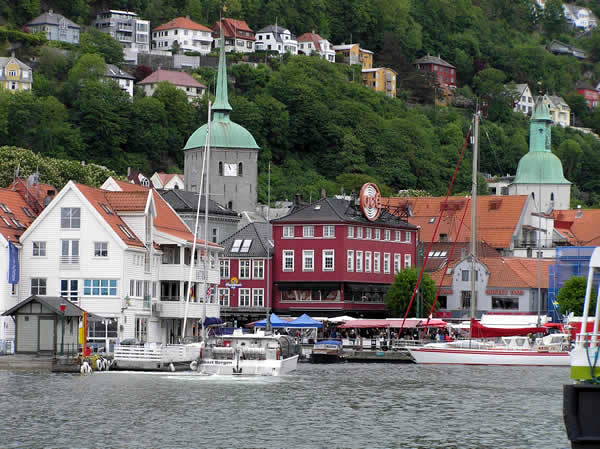This post is also available in:
![]() Deutsch
Deutsch ![]() Italiano
Italiano ![]() Português
Português ![]() Español
Español
The city of Bergen, the historical jewel of the country, is a city full of charm and atmosphere. This historic inhabited center is located on a peninsula along the Norwegian southwest coast, in the center of the fjord region of Norway. The city is surrounded by picturesque reliefs, called the Seven Mountains (De syv fjell). Bergen is the historical capital of Norway, in fact since the Middle Ages it was the main city in the country, and only after 1830 was it exceeded by the number of inhabitants from Oslo. Today Bergen is the second largest city in Norway, its urban area reaching 230,000 inhabitants.
According to tradition, Bergen was founded in 1070 by King Olav Kyrre and from the 13th century onwards became the capital of Norway. At that time it was the most important port in the country and one of the most important commercial cities of the Hanseatic League. Its importance was due to the trade of dried cod which in summer arrived in Bergen from all over Norway and which was transported and sold from here by the German traders of the Hanseatic League throughout Europe.
BRYGGEN: THE ANCIENT PORT
The ancient port area of Bergen, the Bryggen, rich in valuable wooden buildings, was included in 1979 by UNESCO in the list of World Heritage Sites. Bryggen is one of the most characteristic corners of the city. Formed by a series of ancient wooden buildings, including a group of Hanseatic houses, some of which date back to the 15th century. In some buildings of the Bryggen there is the Hanseatic Museum of Bergen (Det Hanseatiske Museum og Schøtstuene) dedicated to the history of the Hanseatic period of the city.
Among the attractions of the city, in addition to Bryggen, there are a characteristic fish market, a beautiful castle (Bergenhus) with real medieval buildings and some churches and some beautiful green spaces such as the Byparken garden. Among the churches, the 12th century Santa Maria in Romanesque-Norman style and the Bergen domkirke, the city’s Gothic cathedral. The city is also home to museums and a beautiful aquarium. The viewpoints on the city that are located on some of the so-called Seven Mountains surrounding Bergen are very beautiful, the most popular are: the Floyen (320 meters high), reachable by a funicular, and the Ulriken (643 meters high ), reachable with an aerial cableway.
BERGENHUS FESTNING (THE FORTRESS OF BERGEN)
Bergen Fortress (Bergenhus Festning) is among the oldest and best-preserved fortresses in Norway. It is located at the entrance to the city port. In medieval times the area of the fortress was known by the name of “Holmen”, this area of the city has a long history as a center of religious, real and military power.
In the 11th century in the area where the fortress is today there were important buildings of local power. There were the ancient cathedral, the bishop’s residence, the royal chapel and a Dominican monastery. The cathedral was built at the end of the 11th century and remained here until 1531, the year in which its destruction was declared for military reasons.

The fortress was built in the first half of the thirteenth century. Today there are two oldest buildings inside: the Håkonshallen and the keep incorporated in the Rosenkrantztårnet. The Håkonshallen, is a building dating from the mid-thirteenth century, which served as a royal residence and reception hall. The Rosenkrantztårnet is a 16th-century tower which incorporates other more ancient defensive structures, including the ancient keep of the fortress from 1270.
A SINGLE WAR EPISODE
The fortifications were improved and enlarged over the centuries, and in the 18th century the two fortifications of Sverresborg and Holmen were united to form the large fortified area still visible today. The only war episode the fortress participated in was on August 2, 1655, and is known as the battle of Vågen. That day the fortress witnessed a bitter naval battle that was fought under its walls between a Dutch fleet, returning from Asia and loaded with valuable goods, and an English fleet.
At the beginning of the hostilities, the garrison of the fort remained neutral, but when a cannon shot fired from an English ship reached the fortress stands killing four soldiers, the commander of the fortress responded to the English fire helping the Dutch fleet to defeat the attackers. After three hours of relentless battle, the British retreated under fire from Dutch ships and the fortress.
BERGEN FISH MARKET
The Fish Market (Fisketorget) in Bergen, which is one of Norway’s most picturesque and lively. It is located in the heart of the city at the end of the harbor bay. Here in addition to buying fresh or dried fish, the fish can be cooked directly by fishermen and eat on specially prepared tables. The Fish Market also has fruit stalls, vegetables, sweaters, souvenirs, jams and flowers.
Hours: June, July and August every day from 7.00 to 19.00. From September to May from Monday to Friday from 7.00 to 16.00.
The climate of Bergen.
Official page of the municipality of Bergen.
This post is also available in:
![]() Deutsch
Deutsch ![]() Italiano
Italiano ![]() Português
Português ![]() Español
Español
